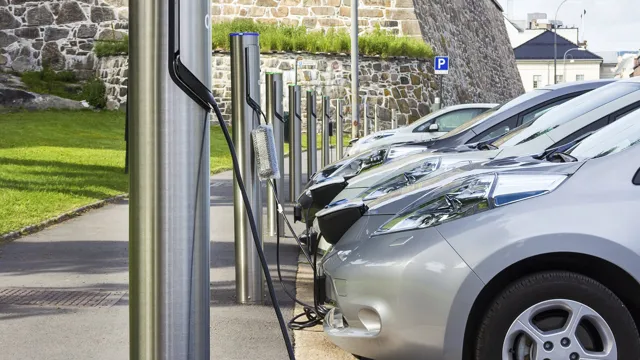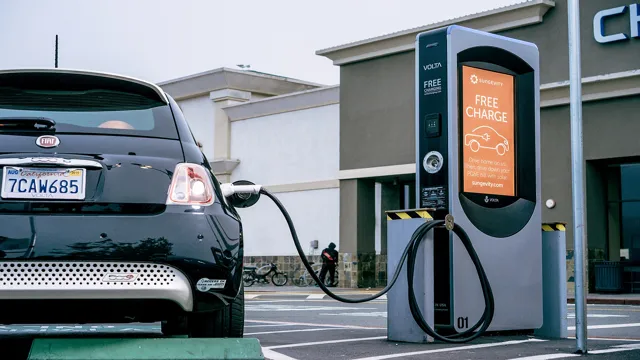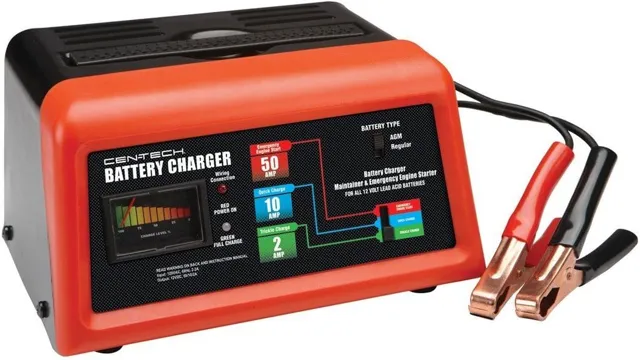Power Up Your Drive: The Ultimate Guide to Battery Charging Stations for Electric Cars
Are you considering making the switch to an electric car? One of the biggest concerns for potential electric car owners is the availability of charging stations. Luckily, as the demand for electric cars continues to grow, more and more battery charging stations are popping up all over the world. Battery charging stations provide electric car owners with a convenient way to refuel their vehicles while out and about.
Similar to gas stations, battery charging stations are typically located in high traffic areas such as shopping centers, hotels, or along major highways. Users simply plug in their car’s charger to the station and wait while their battery charges up. But how long does it take to charge an electric car at a battery charging station? This can vary depending on the type of charger and the size of the car’s battery.
Level 1 chargers take the longest at around 8-20 hours, while Level 2 chargers take only 3-8 hours. Fast charging stations, also known as Level 3 or DC fast chargers, can charge a car up to 80% in as little as 30 minutes. Battery charging stations not only make it easier for electric car owners to refuel their vehicles, but they also help to reduce greenhouse gas emissions.
As more and more people begin to drive electric cars, the demand for battery charging stations will only continue to grow. So the next time you see a charging station while out and about, know that they are helping to create a cleaner and more sustainable future.
The Importance of Convenient Charging
Battery charging stations for electric cars are becoming increasingly important as more and more people are making the switch to electric vehicles. Convenience is a key factor for EV owners, and having access to reliable and convenient charging solutions is crucial to their daily routine. It’s not just about having a place to charge your car, it’s about having a charging station that is accessible, easy to use, and can quickly charge your battery.
Imagine being on a long road trip and suddenly realizing that your car battery is running low – without a charging station nearby, you could be stranded for hours. That’s why having an extensive network of charging stations, including fast-charging options, is essential to the success of the EV industry. By investing in battery charging stations for electric cars, we can help to make driving an EV a more seamless and convenient experience for all.
Longer trips with more charging options
Convenient Charging Going on longer trips with an electric car can be exhilarating, but it’s important to have convenient charging options along the way. This is because the burstiness of charging stations can be unpredictable, so it’s crucial to plan ahead and map out your route accordingly. With the increasing popularity of electric cars, there are now more charging stations available at a wider range of locations, including rest areas, gas stations, shopping centers, and more.
This means that drivers can feel more confident when embarking on longer journeys, knowing that they won’t run out of battery power before reaching their destination. However, it’s still important to plan carefully and take advantage of the charging options available to ensure that you can enjoy a smooth and uninterrupted journey. When selecting charging stations, consider the types of chargers available, the speed of the charge, and the location.
Having more charging options that are conveniently located along your route can make a big difference in the overall experience of your trip. So, don’t be afraid to take on a longer journey in your electric car, just be sure to plan ahead and take advantage of the growing number of convenient charging options available.

Lower emissions when charged with renewable energy sources
Electric vehicles (EVs) are becoming increasingly popular, and for good reason. One major benefit is that they emit fewer pollutants and greenhouse gases than traditional cars, especially when they are charged using renewable energy sources. This is where the importance of convenient charging comes in.
If EV owners have easy and reliable access to charging stations that use renewable energy, they are more likely to choose to charge their vehicles in an eco-friendly way. This not only helps to reduce emissions, but also promotes a sustainable and greener future. So, investing in convenient and accessible charging options is crucial if we want to encourage the widespread adoption of EVs and lower emissions across the board.
Types of Charging Stations
Battery charging stations for electric cars come in various types to accommodate different charging needs. Level 1 charging stations typically plug into a standard household outlet and provide a slow charging rate of around 4-5 miles of range per hour. Level 2 charging stations require a 240-volt circuit installation and provide a faster charging rate of about 10-20 miles of range per hour.
DC fast charging stations are the quickest charging option available, with a charging time under an hour for an 80% charge. These stations require specialized equipment and are often found at public charging stations, making them a convenient option for longer trips. Some charging stations also offer additional features such as mobile phone apps for remote monitoring and control, as well as the ability to schedule charging times for off-peak periods.
Understanding the different types of charging stations available can help you choose an option that suits your charging needs and preferences. So, before you buy an electric car, consider what type of charging station will work best for you.
Level 1 vs. Level 2 charging stations
Types of Charging Stations Electric vehicles are becoming increasingly popular, and one of the key factors of their adoption is the availability of charging infrastructure. Charging stations come in two variants – Level 1 and Level Level 1 charging stations are designed to use a standard 120-volt outlet and deliver up to
4 kW of power. They are best suited for overnight charging or as a backup option. Level 2 charging stations, on the other hand, require a higher voltage and amperage feed and deliver up to 1
2 kW of power. They are ideal for commercial applications or when quicker charging is required. Most electric vehicles are compatible with Level 1 and Level 2 charging stations, and it’s important to note that Level 2 charging stations require professional installation and may require upgrades to existing electrical infrastructure.
Ultimately, the choice between Level 1 or 2 charging stations will depend on your specific needs and usage patterns, and it’s always a good idea to consult with a licensed electrician before making any decisions.
DC fast charging stations and their benefits
When it comes to charging electric vehicles, there are several types of charging stations available. One of the most popular options is the DC fast charging station, which is designed to provide a quick and efficient charge for electric vehicles. DC fast charging stations use a direct current to charge the batteries of electric vehicles, which allows for a faster charging time compared to AC charging stations.
Typically, DC fast charging stations can charge an electric vehicle up to 80% in around 30-40 minutes, making them a popular choice for drivers who need to quickly top up their battery. Additionally, DC fast charging stations can be found in a variety of locations, from public charging stations to privately-owned charging stations, which provides drivers with more options for charging their vehicles. Overall, the benefits of DC fast charging stations include faster charging times and increased convenience for drivers, making them an excellent choice for electric vehicle owners.
Popular Charging Networks
Battery charging stations for electric cars have become increasingly popular in recent years, and there are several charging networks that have emerged as the most widely used. One of the most well-known is Tesla’s Supercharger network, which has over 1,600 stations worldwide and offers high-speed charging exclusively for Tesla owners. Other popular networks include EVgo, which has over 800 fast-charging stations across the US and offers a variety of membership options, and ChargePoint, which has over 100,000 charging locations globally and offers both public and private charging options.
These networks, along with several others, have made it easier than ever for electric car owners to find convenient and reliable charging options while on the go. With more and more people making the switch to electric cars, the demand for battery charging stations will only continue to grow.
Tesla Supercharger network
The Tesla Supercharger network is one of the most popular charging networks for drivers of electric vehicles. These chargers can be found at different locations, including shopping malls, restaurants and other public areas. Tesla has been able to build such a robust charging network because it designs its own custom charging system and partners with businesses to install the Supercharger stations.
The charging times on these Superchargers are incredibly fast, allowing Tesla drivers to recharge their cars quickly without any worry of running out of power. In addition, Tesla provides a mobile app, which enables drivers to locate the nearest charging station easily. The popularity of the Tesla Supercharger network has spawned other charging networks to attempt to compete, but the Tesla network remains the most comprehensive one available.
Whether you are a Tesla owner or not, the Supercharger network is a good indication of where charging-networks are headed in the future.
ChargePoint network
If you’re in the market for an electric vehicle, one of the considerations is finding a reliable charging network. ChargePoint is a popular charging network that offers over 115,000 charging stations across the globe. The network is user-friendly, as it allows users to quickly and conveniently locate available charging stations, start a charging session, and pay for their charging usage.
ChargePoint’s goal is to create an open EV charging network that enables drivers to have flexibility and freedom on the road. They understand the importance of ensuring that the charging experience is seamless and easy, and thus have designed their charging stations and mobile app with the user in mind. ChargePoint’s immense reach ensures that electric vehicle drivers can travel far and wide without worrying about running out of power.
Overall, ChargePoint is a reliable and accessible charging network that’s worth considering for all EV drivers.
EVgo network
EVgo is one of the most popular charging networks for electric vehicles in the United States. They have over 800 fast-charging stations that are strategically placed in urban areas and along highways. These stations can be found in 34 states, making it easy for drivers to locate a charging station wherever they go.
One of the most significant advantages of using EVgo’s network is that they have some of the fastest charging speeds available, with some stations capable of providing up to 350 kW of power. This means drivers can get back on the road quickly, without having to wait around for their vehicle to charge. In addition, EVgo’s network is incredibly reliable, with 98% uptime, ensuring that drivers can always rely on their charging stations being available when they need them.
Overall, EVgo is an excellent choice for EV owners who want fast, convenient, and reliable charging.
The Future of Charging Stations
Battery charging stations for electric cars are the future of sustainable transportation. As more and more people adopt electric vehicles, the need for reliable and efficient charging infrastructure becomes increasingly important. The good news is that the technology for charging stations is rapidly evolving, with new models offering faster charging times and increased flexibility.
Modern charging stations can be installed both at commercial and residential locations. In the near future, we can expect to see an impressive increase in the number of charging stations worldwide, with new developments such as wireless charging becoming more accessible and widespread. Battery charging stations will continue to be vital in the transition towards a greener future, and their popularity will continue to grow as the technology continues to improve.
Wireless charging technology advancements
Wireless charging technology has come a long way since its inception, and the future of charging stations looks to be bright. With advancements in wireless charging technology, charging will be more accessible and convenient than ever before. Imagine being able to charge your phone or tablet without having to plug in a charger.
Imagine being able to charge your electric car while you are parked at a coffee shop or a retail store. These possibilities are becoming a reality with the latest wireless charging systems. The new wireless charging technology uses electromagnetic fields to transfer energy from the charger to the device.
This method of charging eliminates the need for cables and chargers, making it a more efficient and convenient way of charging devices. With the development of wireless charging pads, charging electronic devices has never been easier. The developments in wireless charging technology have made charging convenient and hassle-free.
As the technology continues to advance, we can expect to see more charging stations in public places, making charging devices even more convenient. With the future of charging stations looking brighter than ever, we can expect to see more wireless charging stations popping up throughout the world, making our lives easier and more connected.
Integration with renewable energy sources
As the world continues to shift towards renewable energy sources, the future of charging stations is becoming more integrated with these options. With advancements in technology, charging station infrastructures can now be built with renewable energy sources in mind, creating a more sustainable and eco-friendly option for electric vehicle charging. By utilizing solar panels or wind turbines to power the charging stations, not only are emissions reduced, but energy costs are also lowered.
This integration also opens up opportunities for battery storage options, allowing surplus energy to be stored and used when needed. As we move towards a greener future, the integration of renewable energy sources into charging stations will become a necessity, and it’s exciting to see the technology advancing towards this goal.
Conclusion
In conclusion, battery charging stations for electric cars are the modern-day equivalent of watering holes for weary travelers. Just as ancient civilizations would rely on reliable sources of water to refresh themselves and recharge their energy, electric car owners can rely on these charging stations to power up their vehicles and keep on the move. And who knows, maybe one day, they’ll become a gathering place for community and conversation, much like those old-fashioned watering holes of yore.
So, let’s raise a toast to battery charging stations and the future of sustainable travel!”
FAQs
What are battery charging stations for electric cars?
Battery charging stations for electric cars are specialized infrastructure designed to recharge the batteries of electric cars.
How do battery charging stations for electric cars work?
Battery charging stations for electric cars work by providing electricity to the vehicle, which charges the battery of the car. The stations are connected to the power grid and usually have a connector for the vehicle that matches the type of charging the car is capable of.
Can electric cars be charged at home?
Yes, electric cars can be charged at home using a charging station or a regular electrical outlet. However, home charging is usually slower than charging at a specialized charging station.
How many types of charging stations are there?
There are three main types of charging stations for electric cars: Level 1, Level 2, and DC Fast Charging. Level 1 and Level 2 charging stations are designed for home or public use, while DC Fast Charging stations are usually found on highways or at rest stops and can quickly charge the battery of an electric car.





